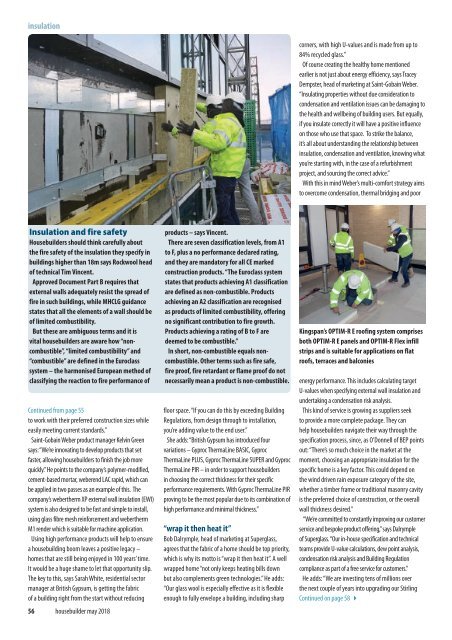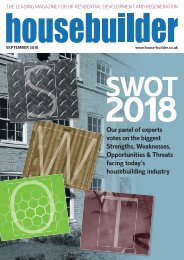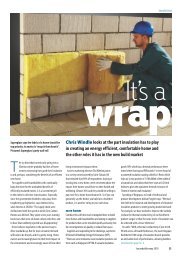Housebuilder Magazine - It's a wrap
Chris Windle looks at the part insulation has to play in creating an energy efficient, comfortable home and the other roles it has in the new build market.
Chris Windle looks at the part insulation has to play in creating an energy efficient, comfortable home and the other roles it has in the new build market.
You also want an ePaper? Increase the reach of your titles
YUMPU automatically turns print PDFs into web optimized ePapers that Google loves.
insulation<br />
corners, with high U-values and is made from up to<br />
84% recycled glass.”<br />
Of course creating the healthy home mentioned<br />
earlier is not just about energy efficiency, says Tracey<br />
Dempster, head of marketing at Saint-Gobain Weber.<br />
“Insulating properties without due consideration to<br />
condensation and ventilation issues can be damaging to<br />
the health and wellbeing of building users. But equally,<br />
if you insulate correctly it will have a positive influence<br />
on those who use that space. To strike the balance,<br />
it’s all about understanding the relationship between<br />
insulation, condensation and ventilation, knowing what<br />
you’re starting with, in the case of a refurbishment<br />
project, and sourcing the correct advice.”<br />
With this in mind Weber’s multi-comfort strategy aims<br />
to overcome condensation, thermal bridging and poor<br />
Insulation and fire safety<br />
<strong>Housebuilder</strong>s should think carefully about<br />
the fire safety of the insulation they specify in<br />
buildings higher than 18m says Rockwool head<br />
of technical Tim Vincent.<br />
Approved Document Part B requires that<br />
external walls adequately resist the spread of<br />
fire in such buildings, while MHCLG guidance<br />
states that all the elements of a wall should be<br />
of limited combustibility.<br />
But these are ambiguous terms and it is<br />
vital housebuilders are aware how “noncombustible”,<br />
“limited combustibility” and<br />
“combustible” are defined in the Euroclass<br />
system – the harmonised European method of<br />
classifying the reaction to fire performance of<br />
Continued from page 55<br />
to work with their preferred construction sizes while<br />
easily meeting current standards.”<br />
Saint-Gobain Weber product manager Kelvin Green<br />
says: “We’re innovating to develop products that set<br />
faster, allowing housebuilders to finish the job more<br />
quickly.” He points to the company’s polymer-modified,<br />
cement-based mortar, weberend LAC rapid, which can<br />
be applied in two passes as an example of this. The<br />
company’s webertherm XP external wall insulation (EWI)<br />
system is also designed to be fast and simple to install,<br />
using glass fibre mesh reinforcement and webertherm<br />
M1 render which is suitable for machine application.<br />
Using high performance products will help to ensure<br />
a housebuilding boom leaves a positive legacy –<br />
homes that are still being enjoyed in 100 years’ time.<br />
It would be a huge shame to let that opportunity slip.<br />
The key to this, says Sarah White, residential sector<br />
manager at British Gypsum, is getting the fabric<br />
of a building right from the start without reducing<br />
56 housebuilder may 2018<br />
products – says Vincent.<br />
There are seven classification levels, from A1<br />
to F, plus a no performance declared rating,<br />
and they are mandatory for all CE marked<br />
construction products. “The Euroclass system<br />
states that products achieving A1 classification<br />
are defined as non-combustible. Products<br />
achieving an A2 classification are recognised<br />
as products of limited combustibility, offering<br />
no significant contribution to fire growth.<br />
Products achieving a rating of B to F are<br />
deemed to be combustible.”<br />
In short, non-combustible equals noncombustible.<br />
Other terms such as fire safe,<br />
fire proof, fire retardant or flame proof do not<br />
necessarily mean a product is non-combustible.<br />
floor space. “If you can do this by exceeding Building<br />
Regulations, from design through to installation,<br />
you’re adding value to the end user.”<br />
She adds: “British Gypsum has introduced four<br />
variations – Gyproc ThermaLine BASIC, Gyproc<br />
ThermaLine PLUS, Gyproc ThermaLine SUPER and Gyproc<br />
ThermaLine PIR – in order to support housebuilders<br />
in choosing the correct thickness for their specific<br />
performance requirements. With Gyproc ThermaLine PIR<br />
proving to be the most popular due to its combination of<br />
high performance and minimal thickness.”<br />
“<strong>wrap</strong> it then heat it”<br />
Bob Dalrymple, head of marketing at Superglass,<br />
agrees that the fabric of a home should be top priority,<br />
which is why its motto is “<strong>wrap</strong> it then heat it”. A well<br />
<strong>wrap</strong>ped home “not only keeps heating bills down<br />
but also complements green technologies.” He adds:<br />
“Our glass wool is especially effective as it is flexible<br />
enough to fully envelope a building, including sharp<br />
Kingspan’s OPTIM-R E roofing system comprises<br />
both OPTIM-R E panels and OPTIM-R Flex infill<br />
strips and is suitable for applications on flat<br />
roofs, terraces and balconies<br />
energy performance. This includes calculating target<br />
U-values when specifying external wall insulation and<br />
undertaking a condensation risk analysis.<br />
This kind of service is growing as suppliers seek<br />
to provide a more complete package. They can<br />
help housebuilders navigate their way through the<br />
specification process, since, as O’Donnell of BEP points<br />
out: “There’s so much choice in the market at the<br />
moment, choosing an appropriate insulation for the<br />
specific home is a key factor. This could depend on<br />
the wind driven rain exposure category of the site,<br />
whether a timber frame or traditional masonry cavity<br />
is the preferred choice of construction, or the overall<br />
wall thickness desired.”<br />
“We’re committed to constantly improving our customer<br />
service and bespoke product offering,” says Dalrymple<br />
of Superglass. “Our in-house specification and technical<br />
teams provide U-value calculations, dew point analysis,<br />
condensation risk analysis and Building Regulation<br />
compliance as part of a free service for customers.”<br />
He adds: “We are investing tens of millions over<br />
the next couple of years into upgrading our Stirling<br />
Continued on page 58 4







